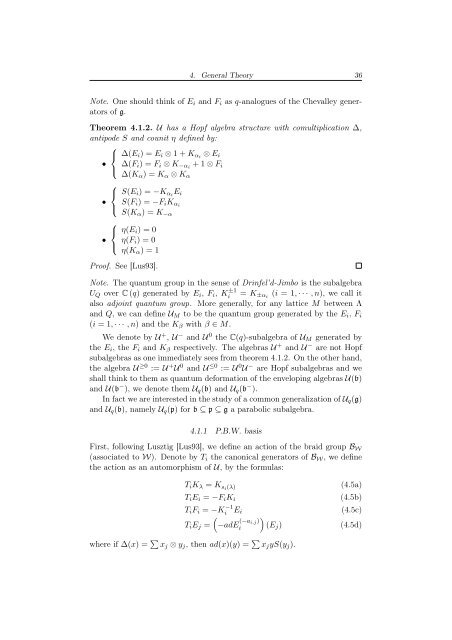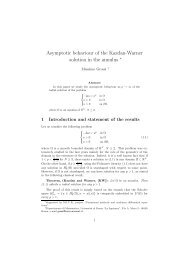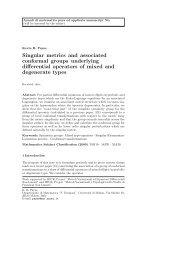Degree of Parabolic Quantum Groups - Dipartimento di Matematica ...
Degree of Parabolic Quantum Groups - Dipartimento di Matematica ...
Degree of Parabolic Quantum Groups - Dipartimento di Matematica ...
You also want an ePaper? Increase the reach of your titles
YUMPU automatically turns print PDFs into web optimized ePapers that Google loves.
4. General Theory 36<br />
Note. One should think <strong>of</strong> Ei and Fi as q-analogues <strong>of</strong> the Chevalley generators<br />
<strong>of</strong> g.<br />
Theorem 4.1.2. U has a Hopf algebra structure with comultiplication ∆,<br />
antipode S and counit η defined by:<br />
⎧<br />
⎨ ∆(Ei) = Ei ⊗ 1 + Kαi ⊗ Ei<br />
• ∆(Fi) = Fi ⊗ K−αi + 1 ⊗ Fi<br />
⎩<br />
∆(Kα) = Kα ⊗ Kα<br />
⎧<br />
⎨ S(Ei) = −Kαi<br />
•<br />
⎩<br />
Ei<br />
S(Fi) = −FiKαi<br />
S(Kα) = K−α<br />
⎧<br />
⎨ η(Ei) = 0<br />
• η(Fi) = 0<br />
⎩<br />
η(Kα) = 1<br />
Pro<strong>of</strong>. See [Lus93].<br />
Note. The quantum group in the sense <strong>of</strong> Drinfel’d-Jimbo is the subalgebra<br />
UQ over C(q) generated by Ei, Fi, K ±1<br />
i = K±αi (i = 1, · · · , n), we call it<br />
also adjoint quantum group. More generally, for any lattice M between Λ<br />
and Q, we can define UM to be the quantum group generated by the Ei, Fi<br />
(i = 1, · · · , n) and the Kβ with β ∈ M.<br />
We denote by U + , U − and U 0 the C(q)-subalgebra <strong>of</strong> UM generated by<br />
the Ei, the Fi and Kβ respectively. The algebras U + and U − are not Hopf<br />
subalgebras as one imme<strong>di</strong>ately sees from theorem 4.1.2. On the other hand,<br />
the algebra U ≥0 := U + U 0 and U ≤0 := U 0 U − are Hopf subalgebras and we<br />
shall think to them as quantum deformation <strong>of</strong> the enveloping algebras U(b)<br />
and U(b − ), we denote them Uq(b) and Uq(b − ).<br />
In fact we are interested in the study <strong>of</strong> a common generalization <strong>of</strong> Uq(g)<br />
and Uq(b), namely Uq(p) for b ⊆ p ⊆ g a parabolic subalgebra.<br />
4.1.1 P.B.W. basis<br />
First, following Lusztig [Lus93], we define an action <strong>of</strong> the braid group BW<br />
(associated to W). Denote by Ti the canonical generators <strong>of</strong> BW, we define<br />
the action as an automorphism <strong>of</strong> U, by the formulas:<br />
TiKλ = K si(λ)<br />
TiEi = −FiKi<br />
(4.5a)<br />
(4.5b)<br />
TiFi = −K −1<br />
i Ei (4.5c)<br />
TiEj =<br />
<br />
−adE (−ai,j)<br />
i<br />
where if ∆(x) = xj ⊗ yj, then ad(x)(y) = xjyS(yj).<br />
<br />
(Ej) (4.5d)








